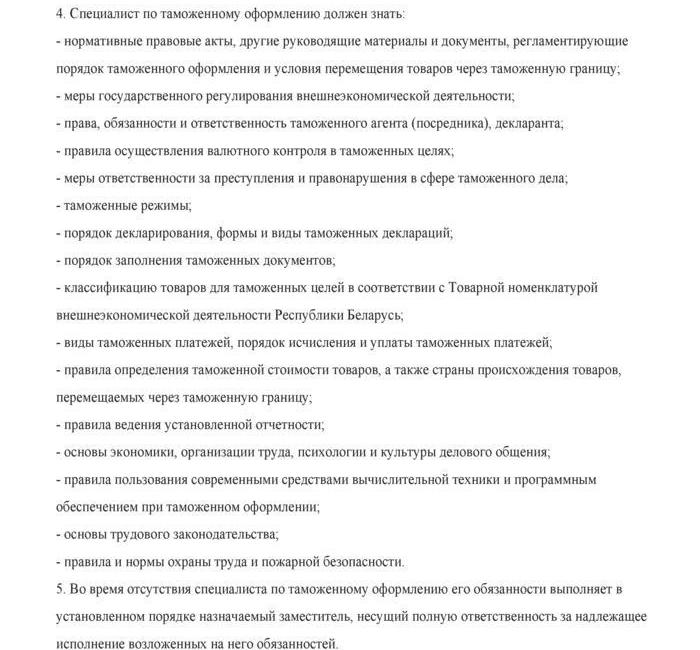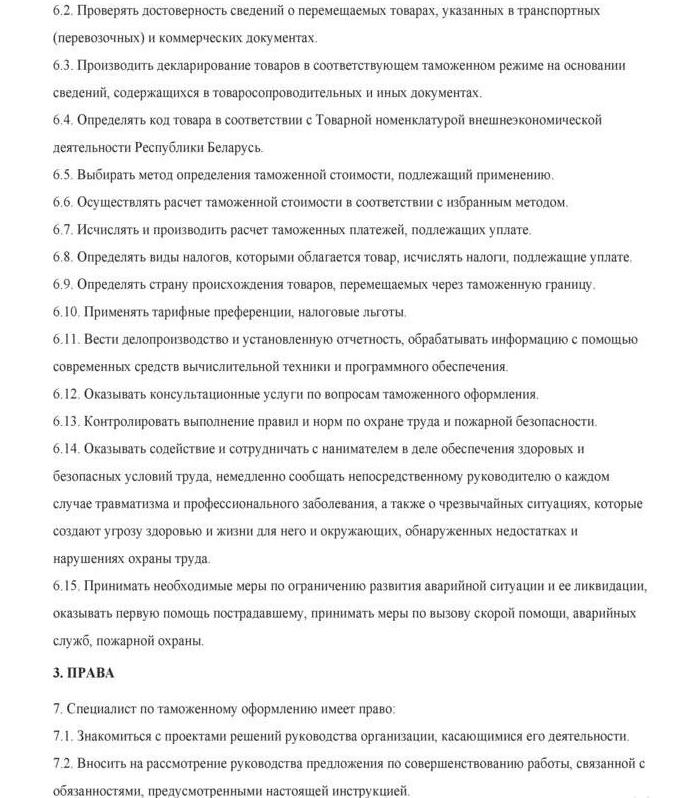Registration of a job description: procedure for registration, requirements and conditions, sample
Any organization is interested in the fact that employees perform their work as efficiently as possible, clearly understanding the goals and objectives set for them. Competent registration of the job description will help in the organization of labor activity.
The procedure for issuing a DI
This document regulates the internal labor relations of employees of the organization. will depend on the specific position, but in general this document should regulate the place and appointment of the worker in the management apparatus, as well as qualification requirements for him, his functional rights, responsibilities and duties, as well as possible incentives.
By law, it is not necessary for a company to issue job descriptions, but this document helps not only in regulating the activities of employees, but also in the event of various kinds of conflict situations within the organization or with the tax office.
According to Rostrud, this document should be separate for each specific position that is on the staff list (even for a vacant one). The instruction expresses the interests of the two parties in the working relationship, because it contains additional information, requirements related to the personal, business qualities of the employee, and more.
In the absence of this document, it becomes impossible:
- justification for refusal to hire;
- an objective assessment of the employee's performance for the period of probation;
- distribution of labor functions among workers;
- temporary transfer of a worker to another job;
- assessment of the conscientiousness and completeness of the employee's performance of his labor functions.
The legislation does not impose specific requirements for the execution of a job description, moreover, the absence of this document is not a violation of the law, and therefore does not entail responsibility. On the other hand, this fact can cause negative consequences in the adoption by the employer of illegal actions and decisions.
Correction and drafting

The basis for the development and execution of job descriptions is the Qualification Directory of Positions. It contains qualification characteristics, which are divided into:
- officials;
- necessary knowledge;
- employee qualification requirements.
It is important to understand that this guide is designed to facilitate the solution of working moments, their settlement, as well as to organize the most effective activities in personnel management. It is only advisory in nature.
Registration of job descriptions of employees is not regulated by legal regulations. Accordingly, the employer independently decides how to issue it and make the necessary changes. The instruction may be an independent document or be an appendix to an employment contract.
The adjustment is often associated with changes in the mandatory conditions in the employment agreement. The employer is obliged to notify the employee in writing in advance of the upcoming changes. If a full-time employee agrees to continue the working relationship, then the instructions are amended accordingly. If it is a TD application, then it is necessary to make changes by drawing up an additional agreement.

The Labor Code does not say anything about the preparation and execution of job descriptions. Despite this, it is the most important document, the content of which includes the terms of reference, labor function, limit of responsibility, as well as qualification requirements. This document is made in 2 copies, one of which is given to the employee.
When issuing a job description in accordance with GOST, they used to rely on the State Standard R 6.30-2003, which was put into effect through the Decree of the State Standard of Russia No. 65-st. dated 03/03/2003, but its effect ceased, since on 07/01/2017 GOST R 7.0.97-2016 came into force. Details that are required to be indicated in this document are described in Section 2 of GOST.
A sample job description is sent for approval to all officials who are interested in it. Any proposals and comments on the project to interested officials can be submitted on separate sheets, which must be dated and signed by employees of the organization. The design of the job description can be based on GOST R 7.0.97-2016, where it is allowed to issue approval visas on the last page at the bottom of the original document. Also, this document can be endorsed by sheets (at the discretion of the enterprise).
Rules for issuing details

The developed state standards serve as a model for the design of the job description. According to them, each type of organizational and administrative documentation must have fully completed details. The order of their arrangement on the sheet is also defined and matters. The job description refers to documents for internal use, so it is not necessary to indicate certain types of details. For example, it does not make sense to prescribe the logo of the organization, its reference data, registration number or OKPO code.
Mandatory details that must be specified in the instructions:
- name of the company, its specific division;
- the name of the document itself (job description), which specifies the specific position for which it was developed;
- OKUD (document form code), for instructions - 0253051;
- date and place where the document was drawn up;
- stamps of approval and approval;
- registration number;
- text part;
- a field that is intended for signatures of familiar persons;
- signature of the official who developed the document.
Main sections
A sample job description according to GOST should include several sections. Each of them is required to consider in detail the following of the questions:
- The content and list of labor functions, as well as a list of types of work performed related to this position.
- Powers and rights of a specialist, their brief description.
- Responsibility that applies to an employee for improper or complete failure to perform work duties.
As for the requirements for the design of the text, they are standard: the width of the lower and upper margins is at least 20 mm. In the text, it is necessary to use special terms that are well-established in the business environment when using speech turns, and it is also necessary to use professional stamps. This style of presentation will help in avoiding an ambiguous interpretation of the meaning, and will also make the information in the text as understandable as possible for the perception of workers.
DI of the customs clearance manager

This employee is classified as a specialist. He is appointed and dismissed from his position by order of the head of the enterprise. The job description of a customs clearance specialist provides that a person who has:
- higher professional education in the specialty "customs" without work experience;
- economic or legal higher education, with work experience of at least a year;
- secondary vocational education with at least 3 years of work experience;
- qualification certificate in the specialty of customs clearance, advanced training courses in the field of customs clearance once every three years.
In his work, this specialist should be guided by:
- the charter of the organization;
- legal regulations, methodological profile recommendations regarding customs clearance;
- instructions, orders of the head;
- his job description.
What a Customs Clearance Specialist Should Know
The manager of this field of activity should know the following:
- legal and regulatory acts, as well as other guidance documents and materials that regulate the conditions for the movement of goods across the border and the procedure for customs clearance;
- customs agent, declarant;
- measures of state regulation of foreign economic activity;
- rules by which currency control is carried out for customs purposes;
- customs regimes;
- measures of responsibility that are applied for offenses and crimes in the field of customs;
- the procedure adopted for declaring, as well as the types and forms of customs declarations;
- the classification that applies to goods for customs purposes;
- the procedure and rules applicable to filling out customs documentation;
- types and classification of customs payments, as well as the procedure that is applied when paying and calculating them;
- the reporting procedure established by the organization;
- the rules applied to determine the customs value;
- fundamentals of communication culture, economics, psychology, labor organization;
- rules for the use of innovative means of technology, as well as software;
- norms and rules of industrial safety, labor protection at the workplace;
- fundamentals of labor law.
Job Responsibilities of a Customs Clearance Manager

A sample job description for this specialist prescribes the following responsibilities:
- Carry out work on the preparation of documentation for goods that are moved across the border, perform other actions that are necessary when organizing customs clearance.
- To declare the goods in the customs regime, based on the information contained in the shipping and other documents.
- Check for accuracy the information about the goods being transported, which are indicated in the transportation and commercial documentation.
- Determine the code of goods based on their nomenclature.
- Choose a method for calculating the customs value and, on the basis of it, carry out the calculation.
- Determine the type of tax on goods, calculate it.
- Determine the country of origin of goods moving across the border.
- Apply tax incentives, tariff preferences.
- Provide advisory services related to customs clearance.
- Maintain records and record keeping, process information.

Rights of the customs clearance manager
The correct execution of the job description implies the following rights of a customs clearance specialist:
- The right to familiarize with draft decisions of managers that directly relate to its activities.
- The right to make suggestions regarding the improvement of work activities.
- The right to report to the management about the existing shortcomings in the organization (within the competence of the specialist), which were revealed in the course of work, as well as to make suggestions for their elimination.
- The right to, on behalf of management or in person, request documents or information from departments of the organization that are necessary in the performance of work duties.
- The right to demand from the management of the organization to assist in the performance of direct official duties.

Relationships, responsibility and evaluation of the work of the customs clearance manager
A sample of the correct design of the job description of this specialist states that he reports to the head of the structural unit. He interacts with employees of structural units on issues that are within his competence.
The requirements for the design of the job description also include the presence of a section of responsibility of a customs clearance specialist. The results of the manager's work activities should be evaluated by the head of his structural unit. The Customs Clearance Manager should be responsible for:
- failure to perform, improper performance of direct official duties;
- causing material damage in the course of work activities (in accordance with the law);
- non-compliance with the rules of labor internal regulations, norms and rules of industrial safety and labor protection.
What tasks does the job description solve?

If this document is drawn up correctly and strictly observed by all employees of the organization, then it will be a support in the work of the enterprise. An example of a job description should be documents that meet state requirements. This will ensure the semantic meaning of this documentation and will be a confirmation of authenticity.
Although the ID of an employee is not included in the list of mandatory documents, but its presence is a big plus in the work of the company. It solves the following production and management tasks:
- a clear definition of job responsibilities for an individual work unit, which is included in the staff list, taking into account all the features of specific tasks and the workplace;
- delineation of job responsibilities, determination of relationships between positions, establishment of a service hierarchy, as well as subordination;
- justification of reimbursement to the worker of certain types of expenses that are due to the performance of his work duties;
- establishing clear and understandable qualification requirements for the position and criteria for evaluating the effectiveness in the performance of duties, as well as compliance with the position held;
- establishing the rights and obligations of a specialist, determining the area of his responsibility and punishment, which is provided for violation or failure to perform official duties.
This document must be drawn up correctly, and also meet the established requirements. The state-level regulations governing the rules for issuing this document are GOSTs, which establish specific requirements for issuing business papers. Previously, GOST R 6.30-2003 was used, but its effect ceased, since GOST R 7.0.97-2016 came into force on July 1, 2017. It is worth paying attention to the fact that the provisions prescribed in the instructions should not in any way worsen working conditions, as well as the position of workers, in comparison with those guaranteed by law.
Additional sections
Some of the most common additional sections in CIs are:
- "Relationships" is a section that regulates the production contacts of employees both from one department and from different ones. If necessary, it prescribes official communications within the organization, as well as with third-party enterprises. This is necessary, for example, if the worker interacts with contractors and there is a need to inform management about this. In order to improve the quality of DI, it will not be superfluous to establish in this section the procedure and frequency for the employee to provide plans, reports and other documents.
- “Evaluation of work” is a section where the criteria are clearly established according to which the evaluation of work will take place.
- "The procedure for reviewing the job description." In this section, it is useful to define the validity period, as well as the conditions for revising the MDI, which include:
- any changes in the organizational structure;
- revision, changes in staffing;
- the emergence of new job responsibilities, which leads to the redistribution of existing ones;
- change in the nature of work due to the introduction of innovative technologies.
Additional sections should be located at the end of the job description.




